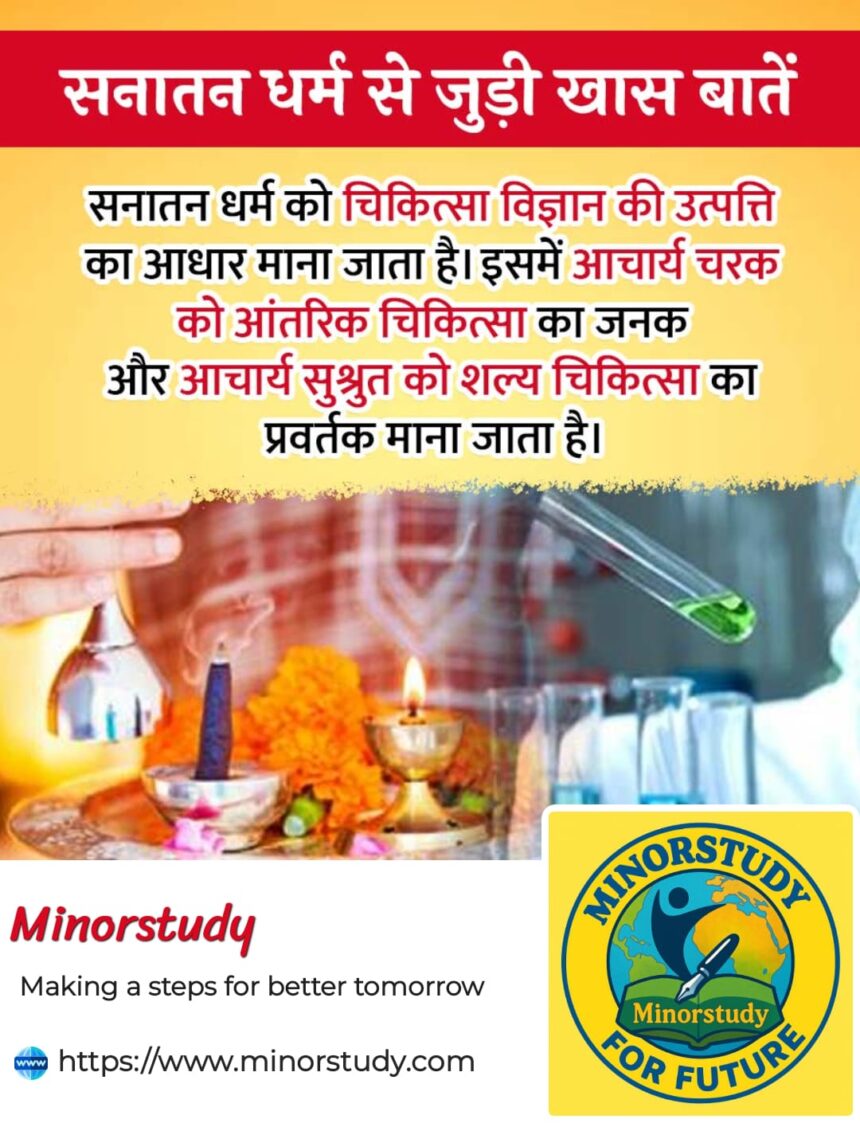Powerful Truths About Sanatan Dharma and Its Eternal Impact on Medical Science
✨ Introduction
Sanatan Dharma, often translated as the “Eternal Way of Life”, is the oldest spiritual and philosophical tradition in the world. Unlike religions that began with a particular founder, Sanatan Dharma is timeless—rooted in cosmic laws, universal values, and human welfare. What makes it unique is its holistic approach to life, which doesn’t separate spirituality from science, culture, or daily living.
- ✨ Introduction
- 📜 History of Sanatan Dharma and Medicine
- 📊 Timeline of Sanatan Dharma and Medical Contributions
- ✅ Interesting Facts About Sanatan Dharma and Medicine
- 🙏 Significance of Sanatan Dharma’s Medical Heritage
- 🎉 Observance and Daily Life Impact
- 💡 Important Points to Remember
- 🙌 Wishing on This Topic
- ❓ FAQs
- 🌍 Importance in Life and Society
- 🏁 Conclusion – Daily Life Impacts
One of the most special things about Sanatan Dharma is its unparalleled contribution to medical science and healthcare systems. From Ayurveda (the science of life) to surgery, Sanatan Dharma has nurtured some of the world’s earliest physicians, including Acharya Charaka (the father of internal medicine) and Acharya Sushruta (the father of surgery).
In this article, let us dive deep into the history, facts, timeline, significance, FAQs, and modern-day impacts of Sanatan Dharma’s contributions—especially in medicine—while also reflecting on its importance in daily life and society.
📜 History of Sanatan Dharma and Medicine
Origins of Sanatan Dharma
Believed to be more than 10,000 years old, Sanatan Dharma was never “founded” but rather “realized” by rishis (sages) who meditated on universal truths.
It emphasizes Dharma (duty), Artha (prosperity), Kama (desire), and Moksha (liberation) as the four goals of life.
Ayurveda – The Science of Life
Ayurveda, a branch of Sanatan Dharma, is considered the oldest medical system known to humanity.
The Atharva Veda contains the earliest references to Ayurvedic practices, covering healing herbs, mantras, and preventive health measures.
Acharya Charaka (1st century CE)
Known as the Father of Internal Medicine, he authored the Charaka Samhita, a foundational Ayurvedic text.
His work emphasized preventive healthcare, diet, lifestyle, and the importance of balance in the body’s three doshas—Vata, Pitta, and Kapha.
Acharya Sushruta (6th century BCE)
Revered as the Father of Surgery, he wrote the Sushruta Samhita, which details over 300 surgical procedures and 120 surgical instruments.
He pioneered techniques like plastic surgery, cataract removal, fracture treatment, and rhinoplasty—centuries before modern science rediscovered them.
Other Contributions
Yoga & Meditation: Rooted in Sanatan Dharma, yoga balances mind, body, and soul—recognized today worldwide for physical and mental health.
Naturopathy & Panchakarma: Cleansing and detoxifying therapies described thousands of years ago are still practiced globally.
📊 Timeline of Sanatan Dharma and Medical Contributions
1500 BCE – Ayurveda first referenced in the Atharva Veda.
1200 BCE – Compilation of Ayurvedic texts and development of herbal medicine.
600 BCE – Acharya Sushruta composes Sushruta Samhita with detailed surgical methods.
100 CE – Acharya Charaka compiles Charaka Samhita, laying the foundation of internal medicine.
5th–10th Century CE – Ayurveda spreads to China, Tibet, and the Middle East.
20th Century CE – Revival of Ayurveda in modern India and recognition worldwide.
21st Century CE – WHO acknowledges Ayurveda and Yoga as global healing sciences.
✅ Interesting Facts About Sanatan Dharma and Medicine
Plastic surgery was first performed in India by Acharya Sushruta.
Sanatan Dharma emphasized mental health through yoga and meditation long before psychology existed.
Ayurveda recognizes 7 dhatus (tissues), which correspond closely to modern medical concepts of body systems.
Pulse diagnosis (Nadi Pariksha) was practiced thousands of years ago in India.
Many modern drugs are derived from plants mentioned in Ayurvedic texts.
🙏 Significance of Sanatan Dharma’s Medical Heritage
Holistic Healing – Treats the body, mind, and soul, not just physical symptoms.
Preventive Medicine – Encourages lifestyle management, seasonal routines, and food discipline.
Surgical Pioneering – Set the stage for modern surgery and medical instruments.
Integration of Science & Spirituality – Unlike modern medicine, Sanatan Dharma connected healing with ethics, spirituality, and compassion.
Global Relevance – From yoga studios to Ayurvedic spas, the world is turning back to these ancient sciences.
🎉 Observance and Daily Life Impact
Sanatan Dharma’s connection to medicine is not just historical—it is practical and relevant in modern times:
Yoga Day (21 June), celebrated globally, has its roots in Sanatan Dharma.
Many households still rely on Ayurvedic remedies like turmeric milk, neem leaves, and tulsi tea.
Mindfulness and meditation practices are now part of stress-relief therapies worldwide.
Ayurvedic centers and wellness retreats are flourishing, showing society’s acceptance of ancient wisdom.
💡 Important Points to Remember
Sanatan Dharma is eternal—not confined to any specific timeline.
Ayurveda is the oldest documented medical science in the world.
Acharya Charaka and Sushruta are timeless role models for healthcare.
The holistic lifestyle recommended by Sanatan Dharma reduces modern diseases like stress, diabetes, and hypertension.
It connects science, spirituality, and humanity in a balanced way.
🙌 Wishing on This Topic
🌸 On this journey of remembering Sanatan Dharma’s medical heritage, may we embrace the wisdom of our ancestors. Let us practice balance, respect nature, and adopt holistic health methods for a healthier body and peaceful mind. 🌸
❓ FAQs
Q1: Who is considered the father of medicine in Sanatan Dharma?
Acharya Charaka, the author of Charaka Samhita, is regarded as the father of internal medicine.
Q2: Who is known as the father of surgery?
Acharya Sushruta, who wrote the Sushruta Samhita, is known as the father of surgery.
Q3: What is Ayurveda?
Ayurveda is the science of life, focusing on balance, natural healing, diet, herbs, and lifestyle.
Q4: How old is Sanatan Dharma?
It is considered eternal, but historically it is traced back at least 10,000 years.
Q5: Why is Sanatan Dharma important for daily life?
Because it emphasizes health, balance, duty, compassion, and spirituality, making life more meaningful.
🌍 Importance in Life and Society
For Individuals: Encourages healthy habits, stress management, and spiritual growth.
For Society: Promotes compassion, preventive healthcare, and ethical living.
For Science: Bridges the gap between ancient wisdom and modern innovation.
For the World: Offers sustainable healthcare methods without over-reliance on chemicals and synthetic drugs.
🏁 Conclusion – Daily Life Impacts
Sanatan Dharma is not just a religion—it is a way of life, a guide for humanity that blends spirituality with science. Its contribution to medical science through Ayurveda, surgery, and holistic health practices is one of the most special things about it.
Even today, when modern medicine dominates, the world continues to seek the healing touch of Ayurveda, yoga, and meditation. This shows that Sanatan Dharma’s wisdom is timeless and universal.
🌟 If we adopt even a fraction of Sanatan Dharma’s principles—balanced diet, mindfulness, compassion, and natural remedies—our lives will be healthier, our societies more peaceful, and our world more sustainable. 🌟








